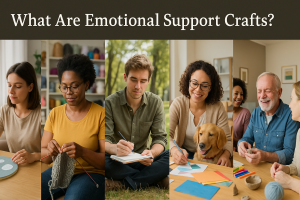Introduction
Many people feel stressed or anxious. Finding simple ways to relax is important. Therapeutic crafting has grown in popularity as a way to calm the mind. This article explores emotional support crafts and why they matter. You will learn what they are, why they help, and how to begin. By the end, you will have tips to create your own stress relief crafts at home.
Crafting is not just a hobby. It can also be a tool for self-care. With a few basic materials, anyone can start making mental health crafts. These project ideas help focus the mind. They offer a break from daily worries. In a world with constant noise, quiet long time with scissors, amount of glue sticks, and double sided paper can be healing. Let’s dive into how crafting can support your emotional health.
What Are Emotional Support Crafts?

Emotional support crafts are creative process activities designed to help people feel better. They include any art or DIY project that gives comfort. People use these crafts to cope with stress levels, reduces anxiety, or sadness. When you focus on a project, your mind can take a break from worries. Crafting lets you express feelings without words. It can be simple, like coloring in a book, or more hands-on, like making a yarn pom-pom. The main goal is to feel calm and safe. These crafts are not art classes or contests. They are just ways to support emotional health. Anyone, from kids to seniors, can use these mental health activities to feel relief.
Popular Types of Therapeutic Crafts

There are many therapeutic benefits of popular stress-relief crafts to choose from. Below are some user-friendly ideas that suit beginners and experts alike.
1. Painting and Coloring
Painting and coloring help you relax by focusing on colors and patterns. You can start with simple adult coloring books. These books have intricate designs that guide your hand. As you stay inside the lines, you feel calm and focused.
If you like more freedom, try painting with watercolors or acrylics. You do not need to be an artist. Even splashing colors on a canvas can feel freeing. Watching the paint blend helps you focus on the moment.
2. Knitting and Crocheting
Knitting and crocheting use repetitive hand motions that many find soothing. With yarn and needles, you can make scarves, hats, or small blankets. The repetitive movements trigger a mild, relaxing rhythm. You also see progress with each row you complete.
Working with yarn can lower blood pressure and heart rate. Over difficult time, crafting projects build patience and concentration. You also create cozy items to gift or keep.
3. Journaling and Scrapbooking
Journaling and scrapbooking blend words and visuals. Starting a gratitude journal, you write down thoughts, draw doodles, or paste photos and stickers. This process helps you reflect on feelings and memories. Creating a scrap paper book of good emotional health times enhances gratitude and joy.
Even a simple gratitude journal prompt, where you note three positive moments each day, can lift your mood. The act of writing and decorating pages focuses your mind on positive thoughts.
4. Clay and Pottery
Working with clay can be a sensory delight. You feel the cool, moist texture in your hands. You shape a lump into a small bowl or a figurine. This form of mindfulness crafting forces you to be present. You cannot rush the process.
Many pottery studios offer classes. If you do not have access, use air-dry clay at home. This clay is safe, non-toxic, and easy to shape. You feel a sense of satisfaction when your creation dries and hardens.
5. Paper Crafts and Origami
Paper crafts include card making, origami, paper flowers, and fun paper quilling strips. You fold and cut paper, use paper glue and hot glue paper to form shapes or designs. These craft activities demand attention to detail, which quiets a racing mind.
Origami, quilling projects the art of folding paper require patience and precision. Beginners start with simple shapes like cranes or frogs. As skills grow, you can try more complex models. Completing an origami piece gives a strong sense of accomplishment.
Comparative Table: Craft Types and Their Emotional Benefits
| Craft Type | Materials Needed | Main Benefits | Skill Level Needed |
|---|---|---|---|
| Painting/Coloring | Paints, brushes, type of paper, coloring books | Stress relief, improved focus | Beginner |
| Knitting/Crocheting | Yarn, needles or hook | Calming rhythm, fine motor practice | Beginner to Intermediate |
| Journaling/Scrapbooking | Paper, pens, stickers, photos | Self-reflection, mood tracking | Beginner |
| Clay/Pottery | Air-dry clay, basic tools, water | Sensory engagement, mindful creation | Beginner to Intermediate |
| Paper Crafts/Origami | Colored paper, scissors, hot glue gun | Precision, patience, cheap materials | Beginner to Advanced |
| Beading/Jewelry | Beads, wire, string, pliers | Focus, creativity, portable keepsakes | Beginner to Intermediate |
| Woodcraft | Wood pieces, sandpaper, basic tools, paint | Tangible results, hand-eye coordination | Intermediate to Advanced |
Conclusion
Emotional support crafts 30 minutes a day makes a strong case as a relaxing trend for 2025. Whether you pick painting and coloring to find focus, knitting and crocheting for soothing rhythm, or clay and pottery for hands-on calm, each craft offers unique benefits. You can reduce stress, boost mood, and build social connections. As you try different craft ideas, you discover which activities speak to you. Remember to work in small amount, regular sessions and to embrace imperfection. Over time, crafting piece of paper becomes a trusted quilling tool to manage daily ups and downs with friends and family.









